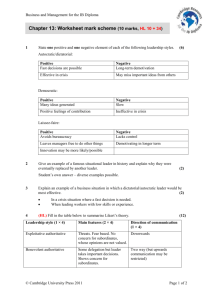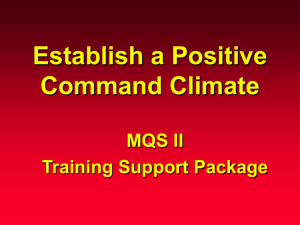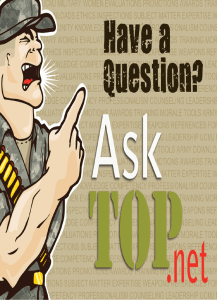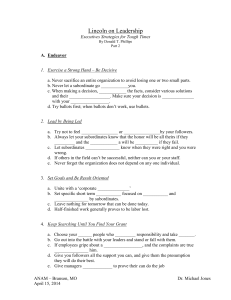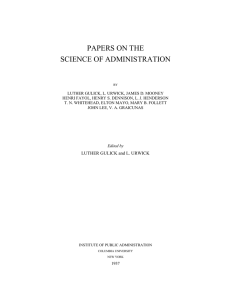Chapters 1& 2
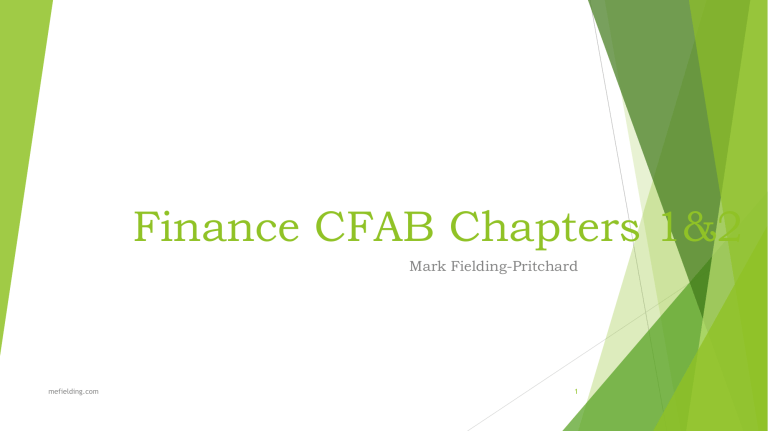
mefielding.com
Finance CFAB Chapters 1&2
Mark Fielding-Pritchard
1
P7 Stakeholders Chapter 1
Directors
Customers
Suppliers
Lenders
Government
Public
Environmental mefielding.com
2
Peter Drucker Objectives P10
Market standing
Innovation
Productivity
Resources
Profitability
Manager& staff performance
Social responsibility mefielding.com
3
Objectives SMART
Specific
Measureable
Achievable
Relevant
Time bound mefielding.com
4
What Is Management Chapter 2
Management is getting things done through other people
Planning
Controlling
Leading
Organising mefielding.com
5
Quinn P27 Culture
Well being of staff
HR
Flexibility
Open
Systems
Inward
Internal environment stable mefielding.com
Internal
Process
Control
Rational
Goal
6
External
Requirements
Outward
External goals
Marketing P30 Chapter 2
FMCGs
White
Brown
Soft
Services mefielding.com
7
Marketing P31 Chapter 2 4Ps
-
-
-
-
-
Product
Price
Place
Promotion
Advertising
Sales promotion
Public relations
Direct marketing
Personal selling mefielding.com
8
Marketing Case Study
Housham Garden mefielding.com
9
Operations Management P36
1. The 4 V’s Overview
All operations processes have one thing in common, they all take their
‘inputs’ like, raw materials, knowledge, capital, equipment and time and transform them into outputs (goods and services). They do this is different ways and the main four are known as the Four V’s, Volume,
Variety, Variation and Visibility.
Volume- MacDonalds
Variety Taxi vs Bus
Variation Barratt vs One off
Visibility UPS mefielding.com
10
mefielding.com
11
mefielding.com
12
mefielding.com
13
mefielding.com
14
The Harvard Model
Employee influence- DOA, power, influence
Human resource flows – recruitment, selection, promotion, termination
Reward systems- salary, motivation
Work systems design of work, alignment of people
This was developed into the 4cs mefielding.com
15
HR Management p39
Commitment
Competence
Congruence
Cost effectiveness
Overall conclusion is that we judge all HR activities on 3 criteria, organization, individual, society mefielding.com
16
McGregor P42 mefielding.com
17
P43 mefielding.com
18
Herzberg P44 mefielding.com
19
Tuckman, Group Action Stages mefielding.com
20
Belbin P46 Team Roles mefielding.com
21
Belbin Strengths mefielding.com
22
Belbin P46 Team Roles 2 mefielding.com
23
Likert Leadership Styles P47 mefielding.com
24
Exploitative Authoritative System
In this type of management system the job of employees/subordinates is to abide by the decisions made by managers and those with a higher status than them in the organization.
The subordinates do not participate in the decision making.
The organization will use fear and threats to make sure employees complete the work set.
There is no teamwork involved.
Benevolent authoritative System
Just as in an exploitive authoritative system, decisions are made by those at the top of the organization and management.
However employees are motivated through rewards rather than fear and threats.
Information may flow from subordinates to managers but it is restricted to “what management want to hear”.
Consultative System
In this type of management system, subordinates are motivated by rewards and a degree of involvement in the decision making process.
Management will constructively use their subordinates ideas and opinions.
This theory is very closely related to the Human Relations theory.
Communication in this system flows both downward and upward , though upward is more limited.
Participative Group System
Management have complete confidence in their subordinates/employees.
There is lots of communication and subordinates are fully involved in the decision making process .
Subordinates comfortably express opinions and there is lots of teamwork.
Teams are linked together by people, who are members of more than one team.
Likert’s calls people in more than one group “linking pins”.
Delegation mefielding.com
29
